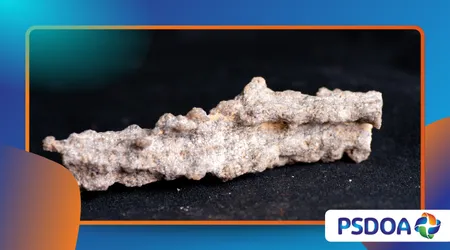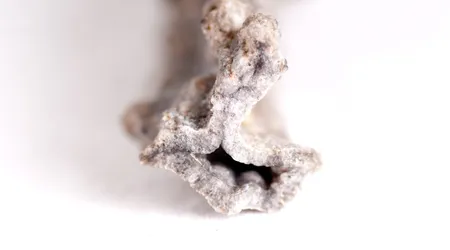Fulgurites: Lightning-Formed Glass Hidden Beneath the Ground

Nature’s raw power often leaves behind spectacular, yet fleeting, displays thunder, floods, or fire. But occasionally, a momentary burst of energy creates a permanent, tangible artifact.
Anúncios
These extraordinary relics are Fulgurites, crystalline tubes of glass formed instantly when lightning strikes the ground. They represent a unique geological phenomenon, the solidified fingerprint of a billion-joule discharge, literally freezing the path of electricity into a subterranean sculpture.
These structures are far more than just natural curiosities. Fulgurites offer scientists invaluable insights into lightning’s incredible thermal energy, the composition of the soil they strike, and even, in rare cases, the history of Earth’s atmosphere.
We will delve into the remarkable science behind these “petrified lightning” formations, explore their geological significance, and understand why these glassy tubes are considered both beautiful and scientifically precious in 2025.
The Recipe for Creation: Extreme Heat and Instantaneous Fusion
The formation of a Fulgurite requires a perfect, volatile convergence of intense energy and specific material conditions. It is a process of geological metamorphosis, compressed into milliseconds.
Anúncios
The Lightning’s Thermal Punch
When a cloud-to-ground lightning strike occurs, it channels an immense electrical current often exceeding 30,000 amperes into the earth. This current generates staggering heat. The temperature can momentarily soar past 1,800 degrees Celsius (3,272 degrees Fahrenheit).
This thermal shock is hotter than the surface of the sun. The heat instantly melts the surrounding silica (quartz) grains found in sand, silicates, and certain soils. This rapid, localized fusion is the core mechanism of Fulgurites creation.
The lightning strike acts as a geological fusion machine, turning common sand into a specific type of amorphous glass called lechatelierite. The entire process, from strike to solidification, occurs in a fraction of a second, preserving the lightning’s trajectory.
++ Super bloom phenomenon: causes, best locations, and the role of climate
Sand, Clay, and the Perfect Ground
The type of ground struck is critical to the quality and size of the Fulgurite. While they can form in various substrates, the most spectacular specimens are found in silica-rich environments like deserts, coastal dunes, or ancient lakebeds.
Dry, uniform sand allows the electrical charge to penetrate deep underground without dissipating immediately. This penetration leads to the formation of long, branching, and deeply set tubes. Clay-rich soils, conversely, often resist deep penetration, typically resulting in shorter, thicker, and less-defined surface structures.
The presence of moisture in the soil dictates the explosive nature of the strike. Water instantly turns to steam, creating the pressure that hollows out the tube. This steam blast is what forms the distinct, hollow inner core of the lightning glass tube.

Architecture of the Underground: Morphology and Scientific Value
The morphology, or shape, of a Fulgurite is a direct map of the lightning’s subterranean path. Their intricate, branching structures provide unique insights into natural electrical discharge dynamics.
Decoding the Branching Networks
Fulgurites never form a straight path. They resemble a branching root system or coral, reflecting how the electrical charge disperses through the material of least resistance. These intricate patterns demonstrate the fractal nature of lightning discharge.
Also read: Light Pillars: Vertical Beams of Ice and Light in Winter Skies
Tubes, Crusts, and Bulbs
Geologists classify Fulgurites based on their morphology:
- Tubular Fulgurites (Sand Fulgurites): The most common form, resembling hollow, fragile tubes often several centimeters in diameter and occasionally meters long, sometimes found to depths of 15 meters.
- Crust Fulgurites (Rock Fulgurites): Formed when lightning strikes solid rock or rock fragments, creating a glassy coating or crust on the surface rather than a deep, hollow tube.
- Massive Fulgurites (Clay/Soil): Irregular, dense glass masses often found in clay or fine-grained soil, lacking the distinct tubular structure due to the ground’s higher electrical resistance.
The study of the branching density within a large Fulgurite can inform scientists about the electrical impedance and conductivity of different soil types, helping to refine geological models of lightning strike zones.
Read more: Moonbows: Rainbows That Only Appear at Night
Microscopic Secrets: Voids and Inclusions
On a microscopic level, Fulgurites are treasure troves of scientific data. The rapid cooling traps tiny gas bubbles (voids) and un-melted mineral fragments (inclusions).
By analyzing the gases trapped within the voids, researchers can study the composition of the air at the exact moment of the strike. Furthermore, the unmelted inclusions provide geologists with a precise snapshot of the pre-strike mineralogy of the soil.
A study from the University of Florida in 2023, analyzing Fulgurites from central Nevada, identified previously unknown ratios of stable nitrogen isotopes trapped in the glass, suggesting new data on atmospheric nitrogen fixation during extreme electrical events.
Global Distribution and Rarity: Where to Find Frozen Fire
While lightning is a global phenomenon, the conditions required to create and preserve large, intact Fulgurites are rare.
The Sand Dunes of Preservation
The vast, arid regions of the world are the best hunting grounds for high-quality Fulgurites. Deserts like the Sahara, the Namib, and the American Southwest offer optimal conditions: dry, deep, and silica-rich sand.
Why Dry Sand is Key
Dry sand is crucial because it acts as an excellent insulator. The lack of moisture prevents the immense electrical energy from immediately diffusing outwards. Instead, the energy is focused into a concentrated channel, allowing the heat to melt the silica deeply and uniformly, creating the long, fragile tubes collectors covet.
The Urban Exception: Concrete and Metal
Interestingly, Fulgurites can also form in urban environments, often when lightning strikes metal pipes or power lines that are grounded in concrete or pavement. These are highly unusual.
These “urban Fulgurites” often contain melted metal alloys and concrete silicates, providing a distinct chemical signature. While scientifically valuable, they rarely possess the intricate beauty of their desert counterparts.
A large-scale survey indicated that intact sand Fulgurites longer than 50 centimeters are found in less than 1 out of every 50,000 lightning strikes in suitable terrain.
| Fulgurite Type | Primary Material | Typical Appearance | Preservation Rarity |
| Sand Fulgurite | Silica (Quartz Sand) | Hollow, fragile, branching tube. | Low (very fragile and easily broken) |
| Rock Fulgurite | Solid Rock / Granite | Glassy surface crust or coating. | Moderate (better resistance to erosion) |
| Clay Fulgurite | Clay / Fine Soil | Irregular, dense, bulbous mass. | High (less intricate, but denser structure) |
Conclusion: The Ultimate Natural Time Capsule
Fulgurites are truly Earth’s most stunning natural time capsules a physical record of colossal energy conversion and localized geological change.
They serve as a powerful reminder that the most spectacular forces of nature operate deep beneath our feet, creating artifacts that merge geology and meteorology in a single, glassy structure.
As research techniques improve, these “frozen lightning” relics will continue to unlock secrets about atmospheric physics and the history of our planet’s mineralogy.
They challenge us to look beyond the momentary flash and appreciate the lasting, silent monuments it leaves behind.
When was the last time you stopped to consider the geological artistry hiding just beneath the surface? Share your thoughts on which natural phenomena you find most fascinating in the comments below!
Frequently Asked Questions (FAQs)
Q: Are Fulgurites radioactive or dangerous to handle?
A: No, Fulgurites are generally not dangerous or radioactive. They are primarily composed of fused silica (glass) and the original minerals of the soil they formed in.
They are physically fragile due to their hollow nature, but they pose no chemical or radiation risk. They are perfectly safe to touch and handle.
Q: How can I tell if a strange rock I found is actually a Fulgurite?
A: The defining characteristic of a true Fulgurite is its glassy inner lining and tubular structure. If you find a branching, irregular, often sand-colored object that is hollow and feels like fused glass or ceramic on the inside, it is very likely a Fulgurite.
Rocks struck by lightning often show scorch marks or localized melting, but a true Fulgurite has the distinct tubular form preserving the path of the current.
Q: Can Fulgurites be man-made?
A: While the natural process is complex, glass tubes similar to Fulgurites can be created in laboratories using extremely high voltage and current sources.
However, the true Fulgurites found in nature possess unique chemical signatures and structural complexity resulting from the multi-phase discharge of natural lightning, which is incredibly difficult to replicate perfectly in a controlled environment. The natural version is always chemically identifiable.
